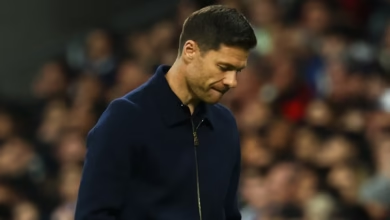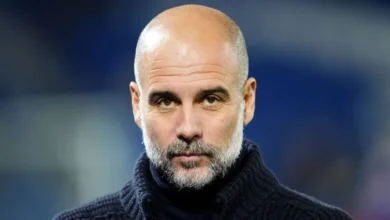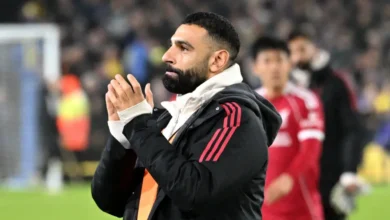The defender Man City released on a free who was even better than Vincent Kompany in training

Vincent Kompany’s name is etched in Manchester City folklore. The Belgian center-back stands as one of the most revered figures in the club’s modern history, a leader who helped transform City from ambitious upstarts to Premier League titans. His commanding presence, aerial dominance, and inspirational leadership made him the cornerstone of City’s defensive foundation during their most successful period.
When discussions arise about Manchester City’s greatest players, Kompany’s name inevitably surfaces. While Kevin De Bruyne famously selected David Silva as the club’s finest talent, few would argue against Kompany’s status as City’s greatest defender. His trophy cabinet speaks volumes: four Premier League titles, two FA Cups, and six League Cups, all while captaining the side through their most transformative era.
Yet, according to former teammate Joleon Lescott, there was another defender at the Etihad Stadium who struck even greater fear into the hearts of his teammates during training sessions. This revelation sheds light on a fascinating aspect of Manchester City’s internal dynamics and highlights a player whose contributions may have been overshadowed by more celebrated names.
The Training Ground Revelation
Joleon Lescott, himself a stalwart of City’s early success under Roberto Mancini, recently made a remarkable claim that has caught the attention of football enthusiasts worldwide. Speaking on Soccer AM, the former England international suggested that while Kompany might hold the title of City’s greatest defender overall, another player dominated one-on-one situations with such intensity that forwards actively avoided confronting him in training.
“Like one-on-one, probably the best around during his time, especially at Man City, would be Micah Richards,” Lescott revealed. “Just an absolute machine. When we used to do one-on-one sessions, no striker or forward wanted to go against him.”
This statement carries significant weight when considering the context. Manchester City’s training sessions during this period were renowned for their intensity and competitiveness. The club was in the midst of establishing itself as a Premier League powerhouse, with substantial investment in both playing personnel and infrastructure. Training sessions weren’t merely preparation for matches; they were battlegrounds where places in the starting eleven were won and lost.
Micah Richards: The Forgotten Warrior
Micah Richards represents a fascinating case study in modern football. A product of Manchester City’s academy system, Richards embodied the club’s transformation from local curiosity to global superpower. His journey began in 2005 when he made his debut for the first team, a young defender with raw talent and unlimited potential stepping into a club on the verge of revolutionary change.
The timing of Richards’ emergence couldn’t have been more significant. He arrived during the final years of the pre-Sheikh Mansour era, witnessing firsthand the club’s metamorphosis from ambitious underdogs to wealthy contenders. His decade-long stint at the Etihad Stadium, spanning 245 appearances, coincided with the most dramatic period in Manchester City’s history.
Richards possessed a unique combination of physical attributes that made him particularly suited to the Premier League’s demanding style. Standing at 5’10” but built like a heavyweight boxer, he combined pace, power, and surprising technical ability. His right-back position required him to excel in both defensive duties and attacking contributions, a dual responsibility he handled with aplomb during his peak years.
The Training Ground Intimidator
Lescott’s revelation about Richards’ training ground dominance provides insight into an aspect of professional football rarely visible to the public. Training sessions at elite clubs are intensely competitive environments where reputations are built and destroyed daily. For a defender to strike fear into forwards during these sessions speaks volumes about their defensive capabilities and mental strength.
“Obviously, it is a toss-up, in terms of that, with Vincent (Kompany) as well, but Micah for just sheer brutality,” Lescott continued. “There was him, Vinny, and Nigel de Jong when I first went there, and it was an eye-opener with the intensity with which they trained at.”
The mention of Nigel de Jong alongside Richards and Kompany is particularly telling. De Jong was infamous for his aggressive playing style and uncompromising approach to defensive duties. The fact that Richards is grouped with these two notorious hard men of football suggests that his training ground reputation was built on more than mere technical ability.
This intensity in training likely contributed to Manchester City’s defensive solidity during their early Premier League-winning campaigns. The culture of uncompromising preparation, where every session was treated as a competitive fixture, helped forge the mental toughness required to succeed at the highest level.
The Shadow of Pablo Zabaleta
One factor that may have contributed to Richards’ relative obscurity in Manchester City folklore is the presence of Pablo Zabaleta. The Argentine right-back joined City in 2008 and gradually established himself as one of the Premier League’s most consistent and reliable defenders. Zabaleta’s consistency, professionalism, and longevity meant that Richards often found himself competing for playing time with a player who would eventually become a club legend in his own right.
This competition for the right-back position created an interesting dynamic within the squad. While Richards possessed superior physical attributes and potentially greater attacking threat, Zabaleta’s tactical intelligence, crossing ability, and defensive positioning made him an increasingly attractive option for successive managers. The Argentine’s ability to maintain high performance levels over an extended period ultimately gave him the edge in terms of regular first-team football.
The comparison between Richards and Zabaleta highlights the different qualities valued by different managers and tactical systems. Roberto Mancini, who favored a more defensive approach, often preferred Zabaleta’s positional discipline and crossing ability. Manuel Pellegrini’s more attacking philosophy might have suited Richards’ pace and power, but by then, injuries had begun to take their toll on the Englishman’s career.
Career Trajectory and Unfulfilled Potential
Richards’ career trajectory represents one of football’s recurring themes: immense potential curtailed by circumstances beyond a player’s control. His early years at Manchester City suggested a player destined for international recognition and sustained success at the highest level. He earned four caps for England and was widely regarded as one of the country’s most promising young defenders.
However, a combination of factors conspired to prevent Richards from reaching his full potential. Injuries played a significant role, with various muscle problems and fitness issues disrupting his development during crucial periods. The constant evolution of Manchester City’s tactical approach under different managers also created challenges for a player whose strengths were perhaps better suited to certain systems than others.
The arrival of numerous high-profile signings following Sheikh Mansour’s takeover intensified competition for places throughout the squad. While this elevated the overall quality of the team, it also meant that players like Richards faced increasingly difficult battles for regular first-team football. The pressure to perform immediately in high-stakes matches left little room for the gradual development that might have allowed Richards to maximize his potential.
The Academy Success Story
Despite the challenges he faced in establishing himself as a consistent first-team player, Richards’ career at Manchester City should be viewed as a success story for the club’s academy system. His progression from youth player to Premier League winner demonstrates the potential pathways available to young talents within the club’s development structure.
Richards’ academy background gave him an intimate understanding of Manchester City’s culture and expectations. This connection to the club extended beyond mere professional obligations; he genuinely embodied the passion and commitment that City fans value in their players. His celebrations after winning the Premier League in 2012 became iconic moments that captured the euphoria of a club achieving its ultimate goal.
The fact that an academy graduate could hold his own alongside expensive signings and established internationals speaks to both Richards’ individual quality and the effectiveness of City’s youth development programs. His success provided a template for future academy prospects and demonstrated that homegrown talent could thrive even in an era of significant financial investment.
Defensive Philosophy and Evolution
The period during which Richards, Kompany, and de Jong formed the core of Manchester City’s defensive unit represents a fascinating chapter in the club’s tactical evolution. Roberto Mancini’s approach emphasized defensive solidity and organization, creating a foundation upon which attacking players could express themselves with freedom.
This defensive philosophy required players who could excel in individual duels while maintaining collective discipline. Richards’ training ground dominance, as described by Lescott, perfectly embodied this approach. His ability to win one-on-one battles provided the team with a reliable last line of defense, while his pace allowed him to recover from advanced positions when necessary.
The intensity of training sessions during this period reflected Mancini’s belief that defensive strength was built through constant competition and pressure. By creating an environment where defenders were regularly tested in challenging situations, the coaching staff prepared players for the various scenarios they would encounter during matches.
The Modern Game Context
Richards’ career coincided with significant changes in how full-backs were expected to contribute to team performance. The traditional model of defensive solidity was evolving toward a more dynamic approach that emphasized attacking contribution and tactical flexibility. This transition created both opportunities and challenges for players like Richards.
His physical attributes and pace made him well-suited to the attacking demands placed on modern full-backs. However, the increasing tactical sophistication of the Premier League required defenders to possess exceptional positional awareness and decision-making abilities. The margin for error was constantly shrinking as opponents became more organized and tactically astute.
The evolution of the game also placed greater emphasis on consistency and reliability. While Richards’ peak performances were undoubtedly impressive, the demands of competing at the highest level required players to maintain excellence over extended periods. This challenge was compounded by the physical demands of the Premier League and the increasing frequency of fixtures.
International Recognition and England Career
Richards’ international career with England, though brief, provided evidence of his quality and potential. His four caps came during a period when England was blessed with considerable depth in defensive positions, making competition for places particularly intense. The fact that he earned recognition at international level demonstrates that his abilities were acknowledged beyond Manchester City.
His England debut came in 2006 against Greece, making him one of the youngest players to represent his country in that position. This early recognition suggested a player destined for sustained international success, but subsequent injuries and competition for places limited his opportunities to build on this promising start.
The contrast between Richards’ limited international recognition and his impact at club level highlights the different criteria used to evaluate players. While his training ground dominance and physical attributes were perfectly suited to Manchester City’s needs during that period, the international game required different qualities that perhaps didn’t align as closely with his strengths.
Legacy and Impact
Despite not achieving the sustained success that many predicted during his early career, Richards’ impact on Manchester City should not be underestimated. His contribution to the club’s first Premier League title in 2012 was significant, and his presence in the squad during their early years of success helped establish the winning mentality that continues to define the club today.
The revelation about his training ground dominance provides a different perspective on his contribution to Manchester City’s success. While statistics and appearances might not fully capture his impact, the psychological advantage gained by having a defender who could intimidate opponents in preparation was undoubtedly valuable.
Richards’ post-playing career as a television pundit and analyst has allowed him to remain connected to the game while sharing insights gained from his playing experience. His articulate analysis and genuine passion for football have made him a popular figure among fans and colleagues alike.
Conclusion: The Unsung Hero
The story of Micah Richards at Manchester City represents more than just the career of a promising defender who faced challenges with injuries and competition. It illustrates the complex dynamics within elite football clubs, where individual battles for supremacy occur daily in training grounds away from public scrutiny.
Joleon Lescott’s revelation about Richards’ training ground dominance adds a fascinating dimension to our understanding of Manchester City’s early success under Roberto Mancini. While Vincent Kompany rightfully receives acclaim as the club’s greatest defender, the acknowledgment that Richards could strike fear into his teammates during training sessions suggests that greatness can manifest in different ways.
The intensity and competitiveness that Richards brought to training sessions helped create the culture of excellence that continues to define Manchester City today. His ability to elevate the performance of those around him through sheer determination and physical dominance represents an often-overlooked aspect of professional football.
As Manchester City continues to evolve and achieve new heights of success, the contributions of players like Micah Richards should be remembered and celebrated. They were instrumental in laying the foundations upon which the current era of dominance was built, even if their individual stories didn’t unfold exactly as anticipated.
The beautiful game is full of such stories – players whose true impact extends beyond statistics and accolades to encompass the intangible qualities that make teams successful. In Richards’ case, his legacy lives on in the memories of teammates who experienced his training ground intensity firsthand and in the winning culture he helped establish at one of world football’s most successful clubs.














